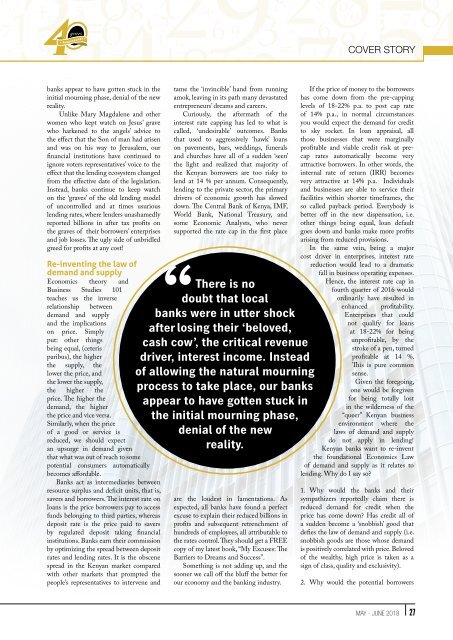May-June-issue
You also want an ePaper? Increase the reach of your titles
YUMPU automatically turns print PDFs into web optimized ePapers that Google loves.
COVER STORY<br />
banks appear to have gotten stuck in the<br />
initial mourning phase, denial of the new<br />
reality.<br />
Unlike Mary Magdalene and other<br />
women who kept watch on Jesus’ grave<br />
who harkened to the angels’ advice to<br />
the effect that the Son of man had arisen<br />
and was on his way to Jerusalem, our<br />
financial institutions have continued to<br />
ignore voters representatives’ voice to the<br />
effect that the lending ecosystem changed<br />
from the effective date of the legislation.<br />
Instead, banks continue to keep watch<br />
on the ‘graves’ of the old lending model<br />
of uncontrolled and at times usurious<br />
lending rates, where lenders unashamedly<br />
reported billions in after tax profits on<br />
the graves of their borrowers’ enterprises<br />
and job losses. The ugly side of unbridled<br />
greed for profits at any cost!<br />
Re-inventing the law of<br />
demand and supply<br />
Economics theory and<br />
Business Studies 101<br />
teaches us the inverse<br />
relationship between<br />
demand and supply<br />
and the implications<br />
on price. Simply<br />
put: other things<br />
being equal, (ceteris<br />
paribus), the higher<br />
the supply, the<br />
lower the price, and<br />
the lower the supply,<br />
the higher the<br />
price. The higher the<br />
demand, the higher<br />
the price and vice versa.<br />
Similarly, when the price<br />
of a good or service is<br />
reduced, we should expect<br />
an upsurge in demand given<br />
that what was out of reach to some<br />
potential consumers automatically<br />
becomes affordable.<br />
Banks act as intermediaries between<br />
resource surplus and deficit units, that is,<br />
savers and borrowers. The interest rate on<br />
loans is the price borrowers pay to access<br />
funds belonging to third parties, whereas<br />
deposit rate is the price paid to savers<br />
by regulated deposit taking financial<br />
institutions. Banks earn their commission<br />
by optimizing the spread between deposit<br />
rates and lending rates. It is the obscene<br />
spread in the Kenyan market compared<br />
with other markets that prompted the<br />
people’s representatives to intervene and<br />
tame the ‘invincible’ hand from running<br />
amok, leaving in its path many devastated<br />
entrepreneurs’ dreams and careers.<br />
Curiously, the aftermath of the<br />
interest rate capping has led to what is<br />
called, ‘undesirable’ outcomes. Banks<br />
that used to aggressively ‘hawk’ loans<br />
on pavements, bars, weddings, funerals<br />
and churches have all of a sudden ‘seen’<br />
the light and realized that majority of<br />
the Kenyan borrowers are too risky to<br />
lend at 14 % per annum. Consequently,<br />
lending to the private sector, the primary<br />
drivers of economic growth has slowed<br />
down. The Central Bank of Kenya, IMF,<br />
World Bank, National Treasury, and<br />
some Economic Analysts, who never<br />
supported the rate cap in the first place<br />
are the loudest in lamentations. As<br />
expected, all banks have found a perfect<br />
excuse to explain their reduced billions in<br />
profits and subsequent retrenchment of<br />
hundreds of employees, all attributable to<br />
the rates control. They should get a FREE<br />
copy of my latest book, “My Excuses: The<br />
Barriers to Dreams and Success”.<br />
Something is not adding up, and the<br />
sooner we call off the bluff the better for<br />
our economy and the banking industry.<br />
If the price of money to the borrowers<br />
has come down from the pre-capping<br />
levels of 18-22% p.a. to post cap rate<br />
of 14% p.a., in normal circumstances<br />
you would expect the demand for credit<br />
to sky rocket. In loan appraisal, all<br />
those businesses that were marginally<br />
profitable and viable credit risk at precap<br />
rates automatically become very<br />
attractive borrowers. In other words, the<br />
internal rate of return (IRR) becomes<br />
very attractive at 14% p.a. Individuals<br />
and businesses are able to service their<br />
facilities within shorter timeframes, the<br />
so called payback period. Everybody is<br />
better off in the new dispensation, i.e.<br />
other things being equal, loan default<br />
goes down and banks make more profits<br />
arising from reduced provisions.<br />
In the same vein, being a major<br />
cost driver in enterprises, interest rate<br />
reduction would lead to a dramatic<br />
fall in business operating expenses.<br />
Hence, the interest rate cap in<br />
fourth quarter of 2016 would<br />
ordinarily have resulted in<br />
enhanced profitability.<br />
Enterprises that could<br />
not qualify for loans<br />
at 18-22% for being<br />
unprofitable, by the<br />
stroke of a pen, turned<br />
profitable at 14 %.<br />
This is pure common<br />
sense.<br />
Given the foregoing,<br />
one would be forgiven<br />
for being totally lost<br />
in the wilderness of the<br />
“queer” Kenyan business<br />
environment where the<br />
laws of demand and supply<br />
do not apply in lending!<br />
Kenyan banks want to re-invent<br />
the foundational Economics Law<br />
of demand and supply as it relates to<br />
lending. Why do I say so?<br />
1. Why would the banks and their<br />
sympathizers reportedly claim there is<br />
reduced demand for credit when the<br />
price has come down? Has credit all of<br />
a sudden become a ‘snobbish’ good that<br />
defies the law of demand and supply (i.e.<br />
snobbish goods are those whose demand<br />
is positively correlated with price. Beloved<br />
of the wealthy, high price is taken as a<br />
sign of class, quality and exclusivity).<br />
2. Why would the potential borrowers<br />
MAY - JUNE 2018 27

















